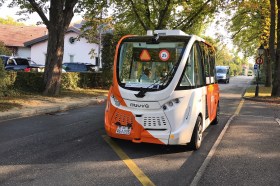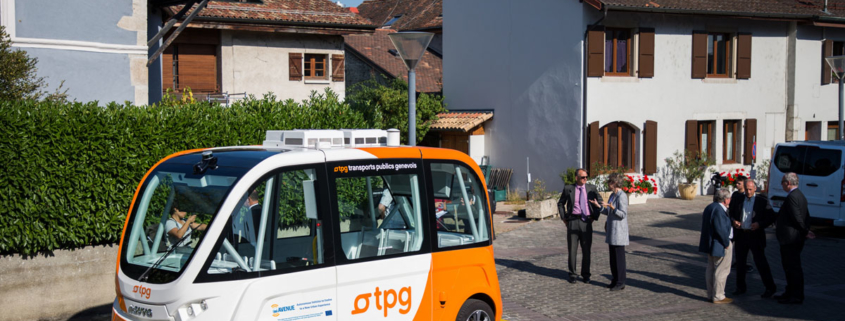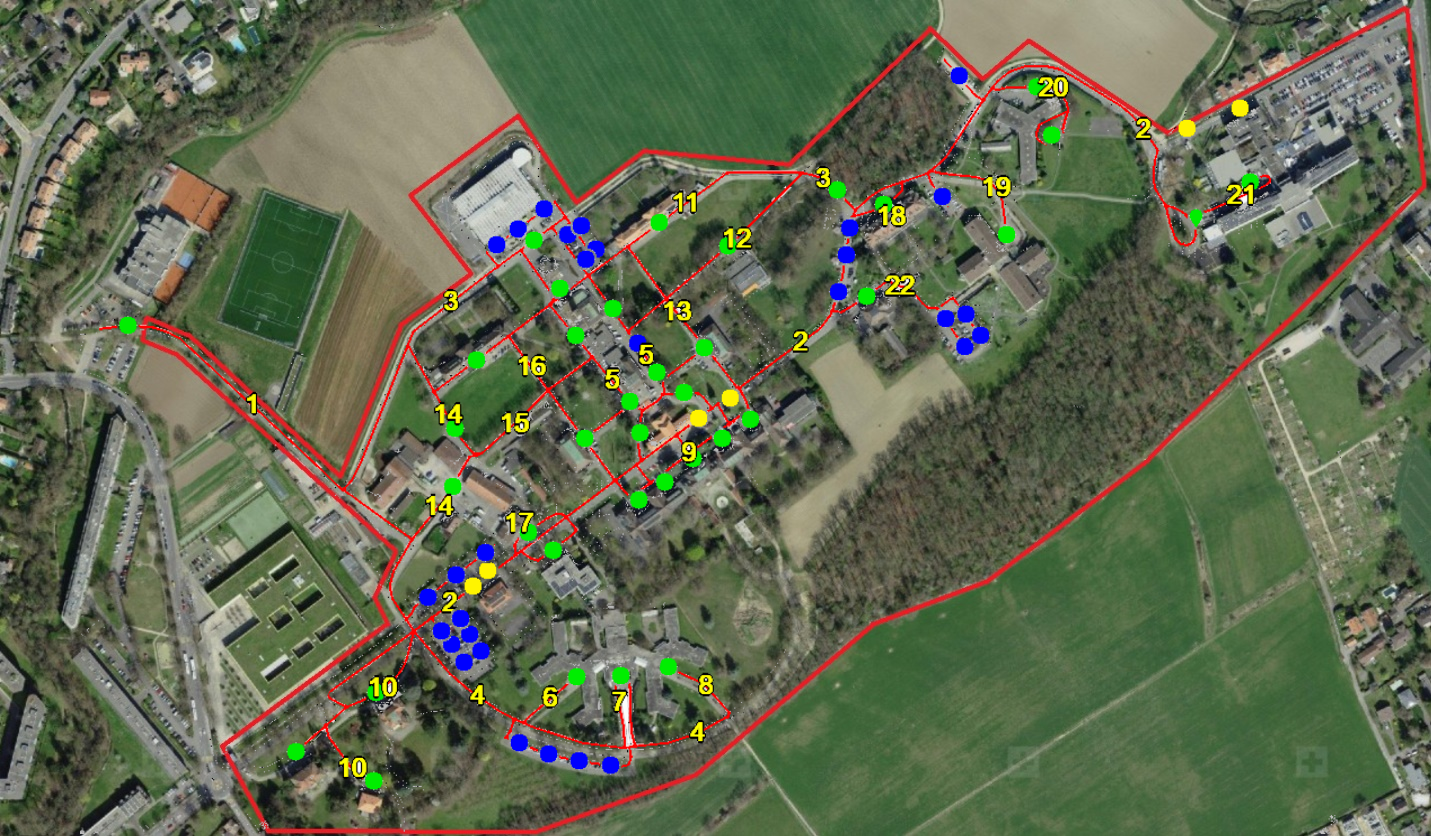Newspaper: Tribune de Genève – Des navettes autonomes pour se déplacer sur le site de Belle-Idée
/in Bestmile, Geneva, Media coverage, Mobile Thinking, Newspaper, TPG, Université de Genève /by Dimitri KonstantasNewspaper: Le Matin – Des navettes autonomes pour se déplacer sur le site de Belle-Idée
/in Bestmile, Geneva, Media coverage, Mobile Thinking, Newspaper, TPG, Université de Genève /by Dimitri KonstantasEvent: TPG live demo presented at Belle-Idee site
/in Bestmile, Event, Geneva, Mobile Thinking, News, TPG, Université de Genève, Video /by Dimitri KonstantasOur autonomous public transport shuttles on-demand, door-to-door service at the Belle-Idee demonstrator site is almost ready for full deployment!
Check out the Transports Publics Genevois (TPG) live demo presented at the H2020 AVENUE project general meeting here:
Video: H2020 AVENUE Geneva TPG Operator Experience
/in Announcement, Geneva, News, TPG, Video /by Dimitri KonstantasMeet Melissa, a Transports Publics Genevois (TPG) operator in Geneva and learn about her experience with the operation of the deployed autonomous shuttles in her city.
TV/Newspaper: SWI Swissinfo – The slow but steady progress of driverless buses in Switzerland
/in Bestmile, EU, Geneva, Media coverage, Mobile Thinking, Navya, Newspaper, TPG, TV / Radio / Video, Université de Genève /by Dimitri KonstantasSource: SWI Swissinfo
Author: Simon Bradley
Date: September 24, 2020
Over the past five years, various kinds of autonomous vehicles, including buses, have popped up on Swiss roads. But though testing continues, a driverless future might yet be some years away.
This article is also available in other languages :
deutch (de) Shuttle-Bus ohne Fahrer ist noch Zukunftsmusik
Português (pt) Ônibus sem motorista na Suíça avança, mas com muitas paradas
中文 (zh) 瑞士无人驾驶公交车虽进展缓慢,却仍在稳步推进
عربي (ar) الحافلات ذاتية القيادة في سويسرا تتقدّم ببطء ولكن بثبات
Français (fr) Les bus autonomes font leur chemin en Suisse
Pусский (ru) Беспилотный транспорт Швейцарии развивается медленно, но верно
Italiano (it) Gli autobus autonomi si fanno strada pian piano in Svizzera
On a crisp autumn morning in the Geneva countryside, a bright orange-and-white electric bus is winding through the leafy 36-hectare grounds of the Belle-Idée hospital site.
The bus is trundling along a gravel path when suddenly a patient and a nurse step out from behind a tree. The vehicle brakes sharply, a bell rings out, a “keep your distance” sign flashes at the front and rear. The couple steps back, and the bus continues slowly on its way.
The toy-like shuttle – empty apart from a safety operator and guided by sensors, GPS and radar – is the centrepiece of a unique driverless public transport experiment.
“It’s a world first for a public transport service,” says Dimitri Konstantas, director of the Information Science Institute at the University of Geneva, who is coordinating the project. “Most sites and lines have a fixed route… but here the difference is that there is no route. You can go anywhere.”
Testing, testing
This summer, a small team began testing the ten-seater vehicles, mapping out the huge Belle-Idée park and its obstacles. In parallel, a Geneva-based start-up, MobileThinking, has been putting the finishing touches to an app that will be tried out by the first passengers before the end of the year.
Then when the project is up and running in the next couple of years, patients, visitors and staff will be able to get around the sprawling complex by using their smartphone to order one of three buses offering an on-demand door-to-door service. External Content
Sign up! Stay connected to Swiss science news and trends
Users will be able to locate a bus via the app, then send a pick-up request. Software from the Lausanne firm Bestmile will indicate when a bus is available and what the journey time will be. A fleet management system will then adapt the vehicle’s route according to other passenger requests.
The idea is to have a completely automated system with a safety operator back at a central depot monitoring the vehicles, says Jeroen Beukers, an autonomous vehicle expert who is running the project for the Geneva public transport authorities (TPG).
“Next week we are installing electric doors on the bus depot. In the future, you’ll make a booking on your phone, the depot doors will open automatically, a charged bus will pick you up from A and take you to B and then either return to the depot or continue onwards to pick up someone else,” he says.

European project
The project is not Geneva’s first driverless bus trial: TPG has been successfully running an automated shuttle on a fixed circular route in Meyrin since 2018.
The Belle-Idée project was selected as part of a four-year European driverless vehicle initiative known as AVENUE (Autonomous Vehicles to Evolve to a New Urban Experience). The European consortium, funded by the European Union’s Horizon 2020 programme, includes pilot schemes in Lyon (France), Luxembourg and Copenhagen (Denmark).
Driverless vehicles in Switzerland
Over the past five years a growing number of other Swiss cities and transport companies have experimented with driverless vehicles on fixed routes (see infobox). This includes Sion, the capital of canton Valais, which in 2016 became the first Swiss city to launch an autonomous bus service in collaboration with Swiss Post.
Apart from the odd minor accident, the results of these trials have been generally positive, with thousands of passengers now regularly taking driverless shuttles.
Swiss ‘pioneer’
The trials have allowed Switzerland “to position itself as a pioneer” in this field, according to Marina Kaempf, spokesperson for the Federal Roads Office.
In most cases the tests were well accepted by the public, with municipalities and cantons developing “realistic” projects to show what the vehicles can do, she tells swissinfo.ch.
But current technologies still don’t allow vehicles that are 100% driverless – i.e. without a safety operator – to be used commercially, the Roads Office says. The exchange of data between driverless vehicles and the outside environment also needs to be improved.
“Longer term, you can imagine driverless buses running more permanently on certain lines when their technologies have been perfected,” says Kaempf. But in the short-term, while autonomous pilot schemes will continue in their current form, the Roads Office is not planning to increase them or turn them into commercial ventures.
Meanwhile, in parallel to these trials, the government is gearing up for the wider use of driverless vehicles on Swiss roads in the coming years. In August, it launched a consultation process to revise the Federal Law on Road Traffic. Part of the proposal aims to improve the legal basis for automated driving and future testing, and to ensure Switzerland can adapt to any international developments in this field.
Huge challenges ahead
Despite Switzerland pushing ahead, not all mobility experts are convinced by driverless buses.
“Maybe they’ll have made big progress in 20 years, but at the moment autonomous buses are a bit of a gadget,” says Vincent Kaufmann, a professor at the Federal Institute of Technology Lausanne (EPFL) and scientific director of the Mobile Lives Forum in Paris.
“What’s interesting is not so much driverless buses, but shared autonomous vehicles, like taxis. We’ll continue to need trams, trains and buses, where you carry 100-200 passengers. But if the shared autonomous vehicle can replace the individual car in the city that’ll be a real gain.”
Driverless challenges – both regulatory and technical – remain huge, raising many questions. Will the introduction of autonomous buses, taxis and privately-owned driverless vehicles just clog up the roads if they are not correctly regulated? How safe will such vehicles be? Will autonomous buses be used downtown or just in suburban areas? How will private data used by autonomous vehicles and passengers be protected? What legal responsibility will public transport firms and drivers have for their autonomous vehicles?
At the technical level, Konstantas feels driverless vehicles still have a long way to go before they can correctly identify objects and anticipate people’s behaviour in the streets.
“Tesla is working on it, but I doubt they’ll be able to do that within 15-20 years,” he says.
He also sees data protection as a big issue. “We’re not allowed to use the data of people walking around in order to learn from it,” he says. “Our system is programmed. It’s not dynamic learning or AI – we don’t have that yet.”
“What we’re doing here is experimental. Is it possible to build the future? We don’t know. Is this going to be useful or not? We don’t know. But we’re going to try.”
On a crisp autumn morning in the Geneva countryside, a bright orange-and-white electric bus is winding through the leafy 36-hectare grounds of the Belle-Idée hospital site.
The bus is trundling along a gravel path when suddenly a patient and a nurse step out from behind a tree. The vehicle brakes sharply, a bell rings out, a “keep your distance” sign flashes at the front and rear. The couple steps back, and the bus continues slowly on its way.
The toy-like shuttle – empty apart from a safety operator and guided by sensors, GPS and radar – is the centrepiece of a unique driverless public transport experiment.
“It’s a world first for a public transport service,” says Dimitri Konstantas, director of the Information Science Institute at the University of Geneva, who is coordinating the project. “Most sites and lines have a fixed route… but here the difference is that there is no route. You can go anywhere.”
Newspaper: Le Courrier – Navettes autonomes
/in Geneva, Media coverage, Newspaper, TPG, Université de Genève /by atelierssudNewspaper: Tribune de Genève – Un bus autonome sera testé dès cet été à Belle-Idée
/in Geneva, Media coverage, Newspaper, TPG, Université de Genève /by atelierssudNewspaper: Heidi.news – De nouvelles navettes autonomes déployées fin juin à Genève
/in Geneva, Media coverage, Newspaper, TPG, Université de Genève /by atelierssudSource: Heidi.News
Date: 19 June 2020
Et s’il était aussi facile de héler un bus autonome qu’un taxi? C’est l’idée derrière les navettes autonomes en cours de déploiement à Genève sur le site de l’hôpital de Belle-Idée, en partenariat avec les Hôpitaux universitaires de Genève (HUG). Deux véhicules commenceront à circuler en test à partir de fin juin 2020 sur le réseau routier du site. Des passagers pourront les emprunter dès le mois d’août.
Pourquoi c’est novateur. Contrairement à la ligne opérée depuis mars 2018 à Meyrin par les TPG sur la ligne XA, la navette ne s’arrêtera pas à des arrêts prédéterminés, mais à la demande, grâce à une application. Une première mondiale pour un site public, explique le coordinateur du projet. Mené par le consortium européen Avenue et piloté par l’Université de Genève aux côtés de la ville et du canton, il pourrait faire des émules en Europe.
Press Release: Green light for the launch of automated vehicles providing an on-demand service at the Belle-Idée site (HUG)
/in Announcement, Geneva, Press release, TPG, Université de Genève /by Dimitri KonstantasGeneva Public Transport (tpg) has reached an important milestone in the AVENUE project. On 3 June 2020, they received formal authorization from the Secretary-General of the Federal Department of the Environment, Transport, Energy and Communications (DETEC) to operate autonomous shuttles on a hospital site located in Thônex in the canton of Geneva.
Already with the benefit of experience in this field with the operation of the XA line in Meyrin since 2018 with autonomous vehicles, tpg will deploy this experimental project on the private site of the clinic of Belle-Idée, in partnership with the Geneva University Hospitals (HUG). The objective is to develop a new generation of on-demand transport services, which are requested via an “application”, and which transports the customer from door to door (shared autonomous public transport). This project represents an opportunity for the HUG to experiment an innovative local transport solution which will be very useful to patients and visitors of the psychiatric and geriatric hospitals (Hôpital des Trois-Chêne), as well as to the personnel working on the site.
An ambitious partnership supported by the European Union
In 2018, the University of Geneva (UNIGE) was chosen to lead the European consortium AVENUE (Autonomous Vehicles to Evolve to a New Urban Experience), alongside tpg and the State of Geneva. The roadmap for this collaborative research project aims to identify the needs and motivation of future users, to face the technological challenges, to update legislation for the use of automated vehicles, as well as to develop business models capable of making this new mode of transport viable, thus contributing to the development of sustainable urban mobility plans.
The AVENUE consortium thus intends to prepare for the technical, legislative and economic integration of the autonomous vehicles in the urban space. These represent a promising solution for the future. With a budget of EUR 20 million over four years, of which 15.6 million are funded by the European Commission under the Horizon 2020 research and innovation programme of the European Union, the AVENUE project brings together 16 partners from across the continent, including five Swiss partners and involves separate experimental projects in Geneva, Copenhagen, Luxembourg, Lyon and Oslo.
In addition to the four players mentioned above, we find in the Swiss consortium MobileThinking, a start-up company of the University of Geneva specialising in mobile application development, and Bestmile, a company created at the Swiss Federal Institute of Technology in Lausanne (EPFL) and active in fleet management of autonomous vehicles.
Several steps planned
Initially, two vehicles of the Navya Autonom Shuttle type, identical to the one of the Meyrin site (autonomous electric vehicle with a capacity of 15 persons), will be put in service on the Belle-Idée site. The tpg plans to integrate them from the end of June 2020 on half of the planned route in order to carry out tests (blank runs) and make the necessary adjustments. By the end of August, they should be able to engage the shuttles on the whole road network within Belle-Idée, without imposing fixed routes and stops. This will then make it possible to field-test a new type of on-demand service whose deployment is conceivable in the long term.
For more information:
François Mutter, spokesman of Geneva Public Transport (tpg)
+41 22 308 31 60 / +41 79 694 49 44 – mutter.francois@tpg.ch
Roland Godel, spokesman of the Infrastructure Department at the State of Geneva
+41 78 802 90 07 – roland.rg.godel@etat.ge.ch
For more details see our deliverable describing the Geneva sites.
Demonstrator & Replicator sites
SUBSCRIBTIONS ARE NOW CLOSED
Contact
Prof. Dimitri KONSTANTAS
Full Professor
Information Science Institute – Director
AVENUE projet Coordinator
Uni Battelle – Office 236
University Of Geneva
Route de Drize 7
1227 Carouge
Switzerland
EU PROGRAM

This project has received funding from the European Union’s Horizon 2020 Research and Innovation Programme under grant agreement no 769033.


 Tribune de Genève
Tribune de Genève





 TPG
TPG